 |
 |
 |
 |
 |
 |
 |
 |
 |
 |
 |
 |
 |
 |
 |
 |
 |
 |
 |
 |
 |
 |
 |
 |
 |
 |
 |
 |
 |
 |
 |
 |
 |
 |
 |
 |
 |
 |
 |
 |
 |
 |
 |
 |
 |
 |
 |
 |
 |
 |
|
|
THE AREA
(Pg.
1)
The
Area Pg. 1
The
Area Pg. 2
The
Area Pg. 3
The
Area Pg. 4
The
Area Pg. 5 |
|
|
|
 |
|
|
|
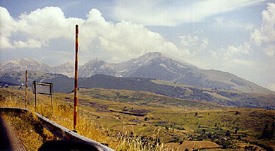 |
|
|
|
View of the Majella from the road above Lu
Lette. The tall pole is to mark the edge of the road in winter, when
the snow is very deep. |
|
|
|
 |
|
|
|
Lu Lette and La Rocca, visible to each other
across the ravine that separates them, are located in the mountainous
interior of the province of Pescara, in the Abruzzo region of Italy.
This region is known for its rugged terrain, which kept its villages and
people isolated until well into the twentieth century. It is said
that the character of the Abruzzese people, who are known for their
strength and independence, was shaped by this geography. Much of
this region is national and provincial parkland, remote and rugged
wilderness. |
|
|
|
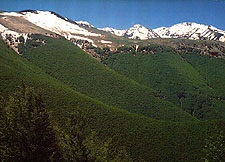 |
|
|
|
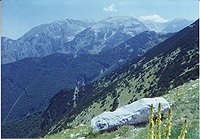 |
|
|
|
|
The western slopes of the Majella
with their characteristic valleys and ravines. Above the forest the
high grassy plateaus, home to the flocks in the summer, are
visible. |
|
|
|
View in the Majella from Block- haus, about 5800
feet above Lu Lette and La Rocca. |
|
|
|
|
|
 |
|
|
|
Lu Lette and La Rocca sit at the edge of the
Majella National Park, in the foothills of the Majella Mountains.
The Majella is a unique dome consisting of multiple peaks. Rising
between the Adriatic Sea and the central Apennines, its eastern side is
very steep and rocky, while its western slopes are somewhat gentler, and
furrowed with many narrow valleys and deep canyons or ravines.
Shallow caves in these canyons and ravines were the site of many isolated
hermitages built by monks as early as 800-1000 A. D. The Majella National
Park provides a habitat to many unique plants (over 1700 species) and to
wildlife including the wolf, Marsican Bear, chamois, wildcat, boar, and
over 130 species of birds. |
|
|
|
The Majella loom over Lu Lette and La Rocca at a
height of 7000-9000 feet. Some say these mountains were named for
the mythical goddess Maia, daughter of Atlas. According to legend,
Maia lost her son while crossing the Adriatic Sea on a raft, died of a
broken heart, and was buried in the cliffs of the Majella Mountains.
It is said that when the winds blow through the cliffs of the Majella,
Maia can be heard crying for her son. |
|
|
|
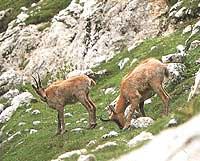 |
|
|
|
 |
|
|
Apennine chamois. |
|
|
|
|
|
|
Marsican bear. |
|
|
|
|
|
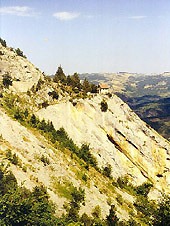 |
|
|
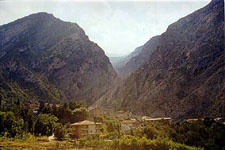 |
|
|
|
|
|
View of the Majella from the eastern (Adriatic)
side. |
|
|
|
|
|
|
A mountainside chapel on the eastern side of the
Majella. |
|
|
|
 |
|
|
|
Lu
Lette | La
Rocca | The
Area | Other
Towns | "Stories"
Lu
Lette Surnames | La Rocca
Surnames | Maps |
Family
Nicknames
Organizations &
Events | Scrapbook |
Genealogy
Help | Links
Sign
Our Guestbook | Home |
View Our
Guestbook
*DOWNLOAD LU LETTE AND
LA ROCCA SONGS*
*DIALECT
VERSE ABOUT A LETTESE AND A ROCCOLANO* |
|
|
 |
|
 |
|
|
La Rocca
Pg. 24 |
|
The Area
Pg. 2 |
|






